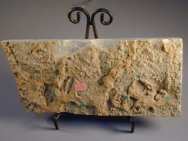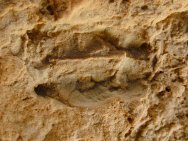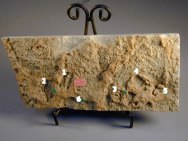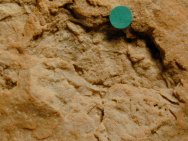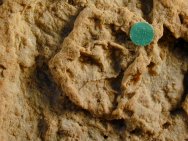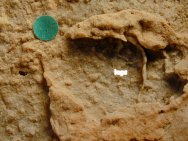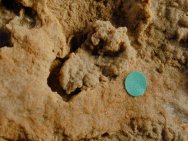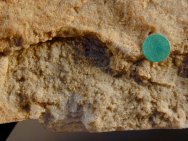Arthropod
Phylum Arthropoda, Euthycarcinoids (?) or Aglaspida (?)
Geologic Time: Upper Cambrian (about 510 million years ago)
Size (25.4 mm = 1 inch): Matrix: 15.7 by 7.2 by 1.5 inches
Fossil Site: Krukowski Quarry, Elk Mound Group, Mount Simon Sandstone, near Mosinee, Wisconsin
Fossil Code: DD509
Price: Sold
|
This is not an ichnofossil. Rather, it is the body fossil(s) of the putative arthropod track maker of Protichnites and Diplichnites trace fossils coming from the Krukowski quarry, which exposes the Elk Mound Group of the Mount Simon sandstone in central Wisconsin. This Cambrian arthropod with body segmentation and tail has resemblance to the enigmatic euthycarcinoids and aglaspids. The Protichnites and Diplichnites tracks found at the site are possibly the oldest terrestrial footprints in the fossil record. This
is one of only 10 fossils (and arguably the best) that will be made
available. The remainder of the small layer is currently being used
for research. The amphibious arthropods come from an interstitial
desiccation layer between sandstone bedding planes (see ichnofossil
nomenclature chart), where they are preserved as ventral, The desiccation zone was likely created by the ingress of fine sediment, clay or mud in a trough, in which the creatures became entrapped and then perished; scratch marks on some specimens attest to the animals struggling to escape. We can hypothesize that, sandwiched between sand layers, the chitinous exoskeletons of the arthropods filled with very fine sand and sediment even as mud and silt leached away, leaving the sandstone body molds to be preserved for the past half billion years. The picture presentation below covers six unequivocal carapaces (numbered in the pictures) with many fine details preserved, especially considering the coarseness of the quartzite sandstone matrix. Depending on the carapace, body segmentation, tail, leg base and legs are noticeable. Good
Reference: |
